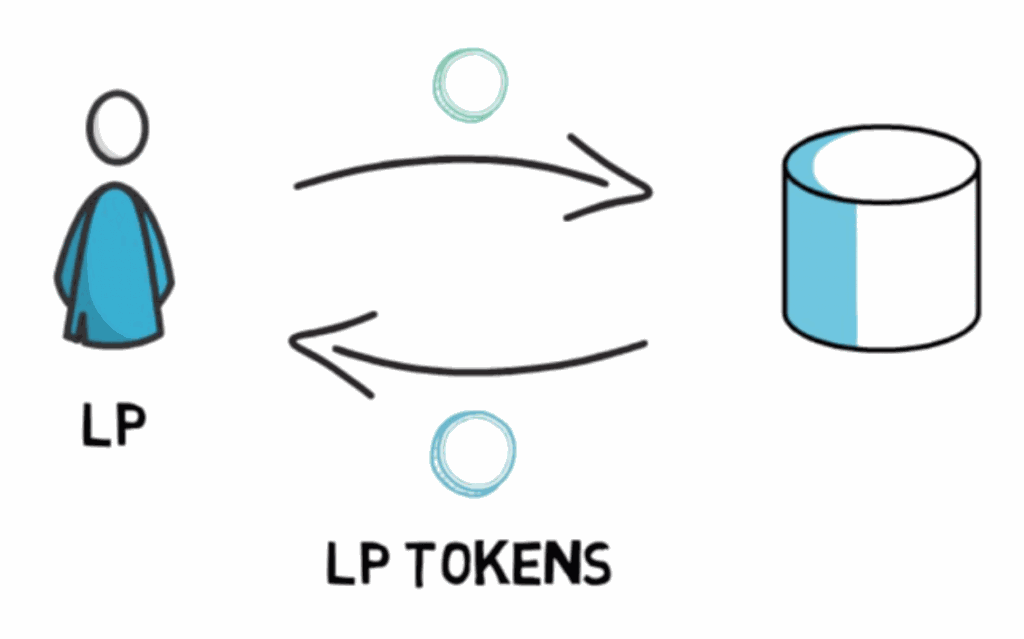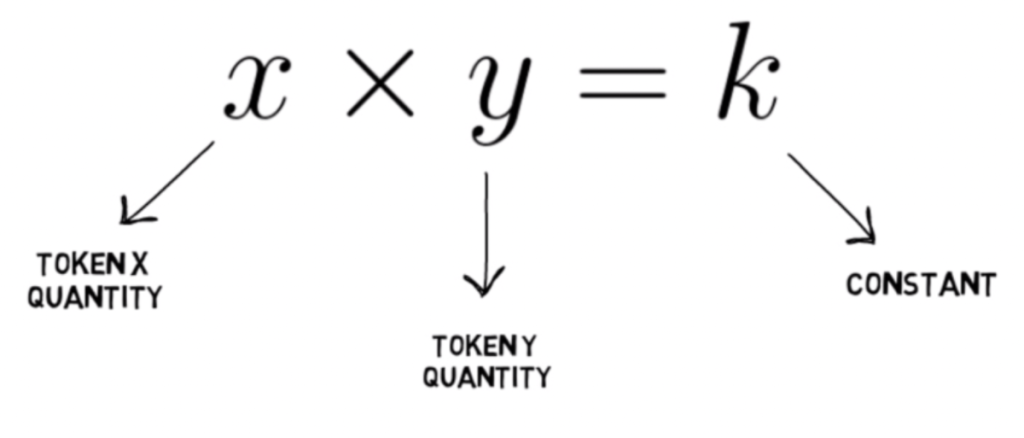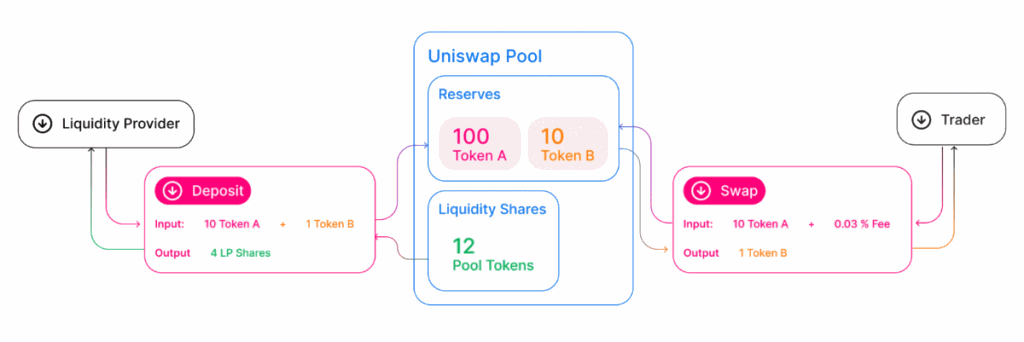
The world of cryptocurrency and decentralized finance (DeFi) has introduced innovative concepts and financial instruments that have transformed the traditional financial landscape. One such concept is the liquidity pool, which plays a crucial role in facilitating efficient trading and financial activities within the DeFi ecosystem. In this article, we will explore what a crypto liquidity pool is, how it works, and why it holds immense importance in the realm of DeFi.
What are Liquidity Pools?
A liquidity pool represents a fundamental concept in the realm of decentralized finance (DeFi), encompassing a grouping of locked coins or tokens within a smart contract. Liquidity pools serve diverse purposes, ranging from facilitating asset trading on decentralized exchanges (DEXs) to supporting lending protocols, yield farming strategies and the creation of synthetic assets.
For example, Liquidity Pool can be used to facilitate trading between assets on a decentralized exchange (DEX), lending protocols, yield farming, synthetic assets, and more.
Liquidity pools play a pivotal role in the thriving DeFi ecosystem, enabling the seamless and permissionless transfer of digital assets. By leveraging the power of liquidity pools, participants can engage in various financial activities and transactions without the need for traditional intermediaries or centralized control.
How Liquidity Pools Work
One of the most crucial groups involved in ensuring the efficient functioning of a liquidity pool is the liquidity providers, also known as liquidity providers.

To ensure the effective operation of a liquidity pool in the cryptocurrency space, it needs to be designed with appropriate incentives to encourage liquidity providers to contribute their assets to the pool. This is why most liquidity providers in the crypto market earn transaction fees and Yield Farming rewards from decentralized exchanges where they provide liquidity.
When users contribute liquidity to a pool, liquidity providers typically receive LP tokens in return. These LP tokens represent their ownership stake in the collective pool and can be utilized across the entire DeFi ecosystem with various capabilities.

For liquidity pools in automated market maker (AMM) protocols, when transactions occur, a transaction fee is retained within the liquidity pool and distributed proportionally among the holders of LP tokens.
AMM-based liquidity pools maintain market value for the tokens within the pool through AMM algorithms. Different protocols may employ slightly different algorithms.
For example, Uniswap’s liquidity pool utilizes the constant product formula (x * y = k) to maintain the price ratio with the number of tokens in the pool.

Why is Liquidity Pool Important in Crypto?
Liquidity pools have emerged as a crucial solution to address liquidity issues in the crypto market, which were previously impacted by centralized exchanges (CEX) and traditional market makers. Before the advent of liquidity pools, the liquidity landscape primarily revolved around a handful of prominent coins and tokens, while long-tail assets (LTAs) suffered from limited liquidity or even illiquidity, posing significant trading challenges.
Liquidity pools were introduced with the objective of mitigating the liquidity problem by incentivizing users to contribute their cryptocurrencies to these pools in exchange for rewards, typically in the form of transaction fees.
Moreover, trading within liquidity pool protocols such as Uniswap, Sushiswap, and others eliminates the need for order matching between buyers and sellers, a characteristic of traditional order book exchanges. This means that users can seamlessly exchange their tokens with those in the pool, leveraging the liquidity provided by other users and conducting transactions through smart contracts.
This innovative approach not only addresses liquidity concerns but also offers diverse applications within the crypto space, particularly benefiting long-tail assets and paving the way for new possibilities in the realm of cryptocurrencies.
Prominent Use Cases of Liquidity Pools in DeFi
Liquidity pools serve crucial purposes within the decentralized finance (DeFi) ecosystem, especially in decentralized exchanges (DEXs), by providing essential liquidity, speed, and convenience.

In the context of automated market maker (AMM) models, liquidity pools enable users to contribute their assets to DEX smart contracts, facilitating liquidity provision for those assets. Consequently, users can seamlessly trade these tokens among themselves, with larger pools equating to higher liquidity and smoother transactions on decentralized exchanges.

To further enhance the trading experience, various protocols offer additional incentives, such as yield farming, to encourage users to contribute liquidity by providing more tokens to LP holders.
Yield farming platforms allow users to earn rewards by providing liquidity, which presents liquidity providers with the task of choosing the most suitable platforms for their funds.
Liquidity pools also form the foundation for profit-generating platforms like Yearn Finance, where users can deposit their funds into pools and earn interest. Yield aggregators and optimizers also enable users to deposit tokens into pools and automatically receive interest. Platforms like Yearn Finance even automate risk allocation, diversifying users’ tokens across different DeFi investments to provide liquidity and generate yield.

Another significant application of liquidity pools lies in lending and debt protocols. Users can deposit tokens as collateral, enabling them to borrow other assets from the platform. The borrowing and lending fees are determined by supply and demand dynamics for those particular assets. Moreover, when users deposit assets, they receive another token representing their ownership rights.
These diverse applications highlight the immense value and versatility of liquidity pools within the DeFi ecosystem, enabling users to actively participate in decentralized trading, yield farming, lending, and debt-related activities while enjoying the benefits of liquidity provision.
Are Liquidity Pools Safe?
Like any investment, liquidity pools come with risks. This is particularly true in the case of DeFi (Decentralized Finance).
However, as liquidity pools gain popularity, more efforts are being made to ensure the security of users’ funds through well-audited smart contracts and increased industry safeguards.
That being said, it’s important to be aware of the risks involved:
- Bugged smart contracts: One of the main risks is the vulnerability of smart contracts. If a smart contract governing a liquidity pool has a bug, hackers can exploit it, potentially leading to a loss of funds. Investing in liquidity pools that have undergone thorough audits by reputable firms is advisable to mitigate this risk.
- High slippage due to low liquidity: Low liquidity in a pool can result in high slippage, meaning the executed trade deviates significantly from the intended transaction price. This occurs when even a small trade substantially impacts the pool’s asset proportions. Some decentralized exchanges (DEXs) allow users to set slippage limits to manage this risk, but setting a low slippage limit may delay or cancel the transaction.
- Frontrunning transactions: Frontrunning happens when a user takes advantage of their position to execute a trade before another user, profiting from the price difference. This risk is more prevalent on networks with slow throughput and pools with low liquidity.
- Impermanent loss: Liquidity providers face the risk of impermanent loss when the price of the underlying asset in the pool fluctuates. If the price decreases, the value of the pool’s tokens also decreases, resulting in a loss for the liquidity provider. Conversely, if the price increases significantly, users may buy from the pool at a lower price and sell elsewhere, resulting in a permanent loss for the liquidity provider.
To minimize these risks, it’s important to carefully evaluate the liquidity pools you participate in, conduct thorough research, and consider diversifying your investments across multiple pools.
Overall, while liquidity pools offer opportunities for earning yields and participating in DeFi, it’s essential to understand and manage the associated risks to ensure the safety of your funds.
Prominent Liquidity Pools
The DeFi space is home to various prominent liquidity pools that have significantly impacted the ecosystem. Some notable examples include:
- Uniswap: Uniswap is a leading decentralized exchange known for its liquidity pools and automated token swaps. It has played a vital role in facilitating token trading and providing liquidity for numerous ERC-20 tokens.
- Curve Finance: Curve Finance specializes in stablecoin trading and offers low-slippage exchanges for stablecoin assets. Its liquidity pools cater to users who require stablecoin liquidity for various DeFi activities.
- Balancer: Balancer enables users to create customizable liquidity pools with multiple tokens, allowing diverse trading pairs and unique investment strategies.
- SushiSwap: SushiSwap is a decentralized exchange and yield farming platform that offers attractive incentives for liquidity providers, driving significant liquidity into its pools.
Conclusion
Crypto liquidity pools are integral to the functioning of the DeFi ecosystem, providing vital liquidity, efficient trading, and yield opportunities for users. By understanding the mechanics and importance of liquidity pools, participants can make informed decisions and contribute to the growth and development of decentralized finance. However, it is essential to be mindful of the risks involved and conduct thorough research before engaging in liquidity provision or trading within these pools. With continued innovation and adoption, liquidity pools are poised to play a pivotal role in shaping the future of finance.

